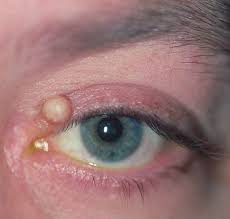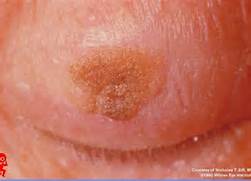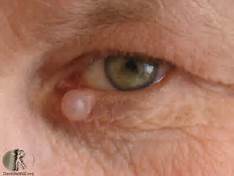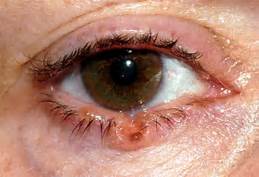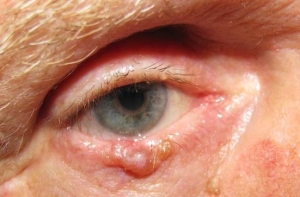Eyelid Lesions
Due to the thinness and complexity of the tissues that make up the eyelids, growths (lesions) of the eyelids are relatively common. Fortunately, a majority of the growths (>80%) are benign, but those that are malignant need to be removed in a timely fashion in order to prevent permanent damage to the eyelid, the eyeball and surrounding eye socket. A thorough history and examination by your ophthalmologist are usually sufficient to make an accurate diagnosis. However, if there is any doubt as to the nature of a lesion, a biopsy needs to be performed and a specimen sent to a pathologist. If a lesion is determined to be benign, it can often be safely observed. In this blog, I will outline the more common lesions and discuss their management.
Lesions of the eyelid can be broadly classified as: inflammatory, infectious and neoplastic (benign or malignant).
Inflammatory
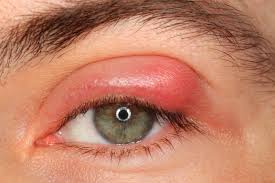
Chalazion: This inflammatory “nodule” (chalazion is Greek for “bump”) is the most common lesion seen by ophthalmologists. It is a localized lesion of an oil secreting gland of the eyelid and initially presents with swelling, pain, and redness. Warm compresses and sometimes topical and oral antibiotics are initially used and most often these lesions resolve. If the “bump” remains it can be removed (with an incision on the back surface of the lid) and/or a steroid injection can be administered.
Infectious
Molluscum Contagiosum: This is the most common infectious lesion of the eyelid and is caused by a “pox” type virus. The lesion presents as a small whitish nodule with a central crater (often seen in multiple numbers). Although most often seen in children, it can be seen in adults with depressed immune systems. If the lesion is close to the eyelid margin, it often presents as a chronic conjunctivitis and is often misdiagnosed as a simple inclusion cyst. These lesions often spontaneously resolve, but can be easily removed if they persist and cause eye irrita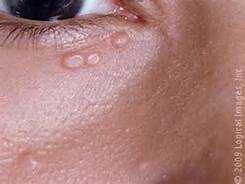 tion.
tion.
Neoplastic – Benign
Squamous cell papilloma: These lesions are due to the exuberant growth of the outer skin layers and often have “finger-like” projections. They can be safely observed; removal is performed if 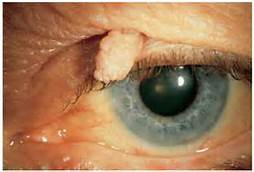 there is significant growth or for purely cosmetic reasons.
there is significant growth or for purely cosmetic reasons.
Epidermal Inclusion Cysts: These smooth, white dome shaped lesions are due to entrapment of the surface layer of skin into the deeper layers. Although benign, “rupture” of these cysts can cause inflammation in the surrounding tissues.
Seborrheic Keratosis: More often seen if the elderly, these benign growths have a “stuck-on” appearance and are often pigmented. They can often grow quite large, but since they are very superficial, they can easily be removed by “shaving” them off of the underlying tissues.
Hidrocystomas: These are cysts that result from the blockage of the ducts of the eyelid sweat glands. They are soft, round and translucent (often with a bluish tinge) and are most often seen on the inner and outer corners of the eyelids. Although they can easily be removed, due to the large number of eyelid sweat glands, they tend to “recur.”
Neoplastic- Malignant
Basal Cell Carcinoma: This is the most common malignant neoplasm of the eyelid and surrounding structures (> 85% of all eyelid malignancies) and presents as a raised growth with “pearly” edges, a central crater with fine blood vessels throughout. Most often, they are seen on the lower eyelid or inner corner of the lid and in people over age 60. Unlike benign lesions, they often scab and bleed. Treatment is by surgical excision with examination of the surrounding tissues at the time of surgery to assure that the lesion is completely excised. Although slow growing, if they are left in place (especially if in the inner corner of the lid), they can grow deep into the eyelid and even into the orbital space surrounding the eye.
Squamous Cell Carcinoma: This is the second most common eyelid malignancy and similar to basal cell carcinoma most often presents in older patients as a painless, irregular nodule with fine overlying vessels. It is usually faster growing and unlike basal cell, it has a propensity to metastasize to local lymph nodes and along adjacent nerves. Wide surgical excision is recommended along with biopsy of facial lymph nodes if there is suspicion of spread.
Sebaceous Cell Carcinoma: Although this is a relatively rare eyelid malignancy, it is one of the most aggressive. Sebaceous cell often appears to be a simple chronic chalazion, chronic conjunctivitis or can mimic a basal cell or squamous cell carcinoma. At the time of diagnosis, it may have already invaded the orbital space surrounding the eyeball or metastasized either to the lymph nodes or other organs. Treatment is with wide surgical excision.
In conclusion, eyelid lesions are relatively common and fortunately the majority are benign and easily diagnosed and treated. Any growth that does not resolve spontaneously or has irregular margins, scabs or bleeds should be promptly evaluated and treated by your ophthalmologist.
Post by Dr. Philip Silverstone. Dr. Silverstone is a specialist in Ophthalmic Plastic and
Reconstructive Surgery. For more information about treatment of eyelid lesions or any
of the services we offer, contact us at any of our 4 offices in Milford, Orange, Branford,
or Shelton.
We’re looking forward to hearing from you soon.

